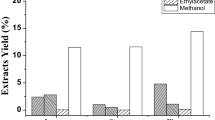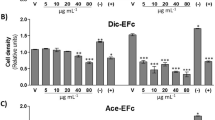Abstract
We evaluated the chemical composition, antioxidant activity, and antitumor potential of a fraction that was isolated from Stryphnodendron adstringens (barbatimão) leaf aqueous extract. Fraction is composed by gallic acid, procyanidin dimer B1, and (−)-epicatechin-3-O-gallate and it exhibits antioxidant and cytotoxic activities. Fraction was cytotoxic against two human breast cancer cell lines, ER (+) and MCF-7 and the triple-negative, MDA-MB-435. The sulforhodamine B assay showed that, as compared to normal control cells, the fraction significantly (P < 0.05) decreased cancer cell viability. The morphological alterations noted in the treated cancer cells were cell rounding-up, shrinkage, and nuclear condensation reduction of cell diameter and length. Treatment with fraction increased cancer cell expression of Bax, caspase-9, active caspase-3, caspase-8, LC-3, and beclin-1 and decreased Bcl-2, caspase-3, and pro-caspase-8 expression. Altogether, fraction is cytotoxic to both breast cancer cell lines, induces cell death, and its mechanism of action seems to include the induction of apoptosis. Our data support a positive role of the fraction as a chemopreventive agent for antineoplastic drug development.





Similar content being viewed by others
References
DeSantis, C. E., Bray, F., Ferlay, J., Lortet-Tieulent, J., Anderson, B. O., & Jemal, A. (2015). International variation in female breast cancer incidence and mortality rates. Cancer Epidemiology Biomarkers and Prevention, 24, 1495–1506.
Myers, M. B. (2016). Targeted therapies with companion diagnostics in the management of breast cancer: current perspectives. Pharmacogenomics and Personalized Medicine, 9, 7–16.
Zemmouri, Y., De Croze, D., Vincent Salomon, A., Rouzier, R., & Bonneau, C. (2016). Caractérisation moléculaire des cancers du sein en pratique clinique. Gynécologie Obstétrique and Fertilité, 44, 285–292.
Li, X., Oprea-Ilies, G. M., & Krishnamurti, U. (2017). New developments in breast cancer and their impact on daily practice in pathology. Archives of Patholology and Laboratory Medicine, 141, 490–498.
Masoud, V., & Pagès, G. (2017). Targeted therapies in breast cancer: new challenges to fight against resistance. World Journal of Clinical Oncolology, 8, 120–134.
Shareef, M., Ashraf, M. A., & Sarfraz, M. (2016). Natural cures for breast cancer treatment. Saudi Pharmaceutical Journal, 24, 233–240.
Brandão, M. G., Zanetti, N. N., Oliveira, P., Grael, C. F., Santos, A. C., & Monte-Mór, R. L. (2008). Brazilian medicinal plants described by 19th century European naturalists and in the official pharmacopoeia. Journal of Ethnopharmacology, 120, 141–148.
Lima, J. C. S., Martins, D. T. O., & Souza, P. T. (1998). Experimental evaluation of stem bark of Stryphnodendron adstringens (Mart.) Coville for anti-inflammatory activity. Phytotherapy Research, 12, 218–220.
Henriques, B. O., Corrêa, O., Azevedo, E. P. C., Pádua, R. M., de Oliveira, V. L. S., Oliveira, T. H. C., Boff, D., Dias, A. C. F., de Souza, D. G., Amaral, F. A., Teixeira, M. M., Castilho, R. O., & Braga, F. C. (2016). In vitro TNF-α inhibitory activity of Brazilian plants and anti-inflammatory effect of Stryphnodendron adstringens in an acute arthritis model. Evidence-based Complementary and Alternative Medicine, 2016, 9872598.
Audi, E. A., Toledo, D. P., Peres, P. G., Kimura, E., Pereira, W. K. V., Mello, J. C. P., Nakamura, C., Alves-do-Prado, W., Cuman, R. K. N., & Bersani-Amado, C. A. (1999). Gastric antiulcerogenic effects of Stryphnodendron adstringens in rats. Phytotherapy Research, 13, 264–266.
Martins, D. T. O., Lima, J. C. S., & Rao, V. S. N. (2002). The acetone soluble fraction from bark extract of Stryphnodendron adstringens (Mart.) coville inhibits gastric acid secretion and experimental gastric ulceration in rats. Phytotherapy Research, 16, 427–431.
Panizza, S., Rocha, A. B., Gecchi, R., & Souza e Silva, R. A. P. (1988). Stryphnodendron barbatiman (Vellozo) Martius: Teor em tanino na casca e sua propriedade cicatizante. Revista de Ciências Farmacêuticas, 10, 101–106.
Pinto, S. C. G., Bueno, F. G., Panizzon, G. P., Morais, G., Dos Santos, P. V. P., Baesso, M. L., Leite-Mello, E. V. S., & de Mello, J. C. P. (2015). Stryphnodendron adstringens: clarifying wound healing in streptozotocin-induced diabetic rats. Planta Medica, 81, 1090–1096.
Felipe, A. M. M., Rincão, V. P., Benati, F. J., Linhares, R. E. C., Galina, K. J., de Toledo, C. E. M., Lopes, G. C., Mello, J. C. P., & Nozawa, C. (2006). Antiviral effect of Guazuma ulmifolia and Stryphnodendron adstringens on poliovirus and bovine herpesvirus. Biological and Pharmaceutical Bulletin, 29, 1092–1095.
Holetz, F. B., Ueda-Nakamura, T., Dias Filho, B. P., Mello, J. C. P., Morgado-Díaz, J. A., Toledo, C. E., & Nakamura, C. V. (2005). Biological effects of extracts obtained from Stryphnodendron adstringens on Herpetomonas samuelpessoai. Memórias do Instituto Oswaldo Cruz, 100, 397–401.
Ishida, K., Mello, J. C. P., Cortez, D. A. G., Dias Filho, B. P., Ueda-Nakamura, T., & Nakamura, C. V. (2006). Influence of tannins from Stryphnodendron adstringens on growth and virulence factors of Candida albicans. Journal of Antimicrobial Chemotherapy, 58, 942–949.
Ishida, K., Rozental, S., de Mello, J. C. P., & Nakamura, C. V. (2009). Activity of tannins from Stryphnodendron adstringens on Cryptococcus neoformans: effects on growth, capsule size and pigmentation. Annals of Clinical Microbiology and Antimicrobials, 8, 29.
Luiz, R. L. F., Vila, T. V. M., de Mello, J. C. P., Nakamura, C. V., Rozental, S., & Ishida, K. (2015). Proanthocyanidins polymeric tannin from Stryphnodendron adstringens are active against Candida albicans biofilms. BMC Complementary and Alternative Medicine, 15, 68.
Morey, A. T., de Souza, F. C., Santos, J. P., Pereira, C. A., Cardoso, J. D., de Almeida, R. S. C., Costa, M. A., de Mello, J. C. P., Nakamura, C. V., Pinge-Filho, P., Yamauchi, L. M., & Yamada-Ogatta, S. F. (2016). Antifungal activity of condensed tannins from Stryphnodendron adstringens: effect on Candida tropicalis growth and adhesion properties. Current Pharmaceutical Biotechnology, 17, 365–375.
Trolezi, R., Azanha, J. M., Paschoal, N. R., Chechi, J. L., Dias Silva, M. J., Fabris, V. E., Vilegas, W., Kaneno, R., Fernandes Junior, A., & Bosco, S. M. G. (2017). Stryphnodendron adstringens and purified tannin on Pythium insidiosum: in vitro and in vivo studies. Annals of Clinical Microbiology and Antimicrobials, 16, 7.
Santos Filho, P. R., Ferreira, L. A., & Gouvêa, C. M. C. P. (2011). Protective against chemical-induced genotoxicity and free radical scavenging activities of Stryphnodendron adstringens (“barbatimão”) leaf extracts. Revista Brasileira de Farmacognosia, 21, 1000–1005.
Rösch, D., Mügge, C., Fogliano, V., & Kroh, L. W. (2004). Antioxidant oligomeric proanthocyanidins from sea buckthorn (Hippophae rhamnoides) Pomace. Journal of Agricultural and Food Chemistry, 52, 6712–6718.
Rösch, D., Bergmann, M., Knorr, D., & Kroh, L. W. (2003). Structure-antioxidant efficiency relationships of phenolic compounds and their contribution to the antioxidant activity of sea buckthorn juice. Journal of Agricultural and Food Chemistry, 51, 4233–4239.
Prieto, P., Pineda, M., & Anguilar, M. (1999). Spectrophotometric quantitation of antioxidant capacity through the formation of a phosphomolybdenum complex: specific application to the determination of vitamin E. Analytical Biochemistry, 269, 337–341.
Yen, G., & Wu, J. (1999). Antioxidant and radical scavenging properties of extracts from Ganoderma tsugae. Food Chemistry, 65, 375–379.
Oyaizu, M. (1986). Studies on products of browning reaction antioxidative activities of products of browning reaction prepared from glucosamine. The Japanese Journal of Nutrition and Dietetics, 44, 307–315.
Lenz, A.-G., Costabel, U., Shaltiel, S., & Levine, R. L. (1989). Determination of carbonyl groups in oxidatively modified proteins by reduction with tritiated sodium borohydride. Analytical Biochemistry, 177, 419–425.
Carvalho, A. J. S., Ishikawa, T., & Gouvêa, C. M. C. P. (2012). Aqueous extract Plinia edulis leaves: antioxidant activity and cytotoxicity to human breast cancer MCF-7 cell line. South African Journal of Botany, 81, 1–7.
Campanella, N. C., da Silva, M. D., Torres, C., de Almeida, E. T., & Gouvêa, C. M. C. P. (2012). The cytotoxic and growth inhibitory effects of palladium(II) complexes on MDA-MB-435 cells. Genetics and Molecular Biology, 35, 159–163.
Lim, Y. C., Lee, S. H., Song, M. H., Yamaguchi, K., Yoon, J. H., Choi, E. C., & Baek, S. J. (2006). Growth inhibition and apoptosis by (−)-epicatechin gallate are mediated by cyclin D1 suppression in head and neck squamous carcinoma cells. European Journal of Cancer, 42, 3260–3266.
Peterson, G. L. (1977). A simplification of the protein assay method of Lowry et al. which is more generally applicable. Analytical Biochemistry, 83, 346–356.
Laemmli, U. K. (1970). Cleavage of structural proteins during the assembly of the head of bacteriophage T4. Nature, 227, 680–685.
Towbin, H., Staehelin, T., & Gordon, J. (1979). Electrophoretic transfer of proteins from polyacrylamide gels to nitrocellulose sheets: procedure and some applications. Proceedings of the National Academy of Science of the United States of America, 76, 4350–4354.
Santos, S. C., Costa, W. F., Ribeiro, J. P., Guimarães, D. O., Ferri, P. H., Ferreira, H. D., & Seraphin, J. C. (2002). Tannin composition of barbatimão species. Fitoterapia, 73, 292–299.
Yang, W., Laaksonen, O., Kallio, H., & Yang, B. (2017). Effects of latitude and weather conditions on proanthocyanidins in berries of Finnish wild and cultivated sea buckthorn (Hippophaë rhamnoides L. ssp. rhamnoides). Food Chemistry, 216, 87–96.
Hixson, J. L., Bindon, K. A., & Smith, P. A. (2015). Evaluation of direct phloroglucinolysis and colorimetric depolymerization assays and their applicability for determining condensed tannins in grape marc. Journal of Agricultural and Food Chemistry, 63, 9954–9962.
Subramanian, A. P., John, A. A., Vellayappan, M. V., Balaji, A., Jaganathan, S. K., Supriyanto, E., & Yusof, M. (2015). Gallic acid: prospects and molecular mechanisms of its anticancer activity. RSC Advances, 5, 35608–35621.
Bigelow, R. L., & Cardelli, J. A. (2006). The green tea catechins, (−)-epigallocatechin-3-gallate (EGCG) and (−)-epicatechin-3-gallate (ECG), inhibit HGF/Met signaling in immortalized and tumorigenic breast epithelial cells. Oncogene, 25, 1922–1930.
Zhou, Y. D., Kim, Y. P., Li, X. C., Baerson, S. R., Agarwal, A. K., Hodges, T. W., Ferreira, D., & Nagle, D. G. (2004). Hypoxia-inducible factor-1 activation by (−)-epicatechin gallate: potential adverse effects of cancer chemoprevention with high-dose green tea extracts. Journal of Natural Products, 67, 2063–2069.
Chahar, M. K., Sharma, N., Dobhal, M. P., & Joshi, Y. C. (2011). Flavonoids: a versatile source of anticancer drugs. Pharmacognosy Reviews, 5, 1–12.
Kedare, S. B., & Singh, R. P. (2011). Genesis and development of DPPH method of antioxidant assay. Journal of Food Science and Technology, 48, 412–422.
Sumantran, V. N. (2011). Cellular chemosensitivity assays: an overview, In Cancer Cell Culture: Methods and Protocols (Cree, I. A., ed.), 2 ed., Methods in Molecular Biology, vol. 731, New York: Springer-Verlag, p. 219–236.
Ekwall, B., Silano, V., Paganuzzi-Stammati, A., & Zucco, F. (1990). Toxicity tests with mammalian cell cultures. In P. Bourdeau, E. Somers, G. M. Richardson, & J. R. Hickman (Eds.), Short-term toxicity tests for non-genotoxic effects (pp. 75–97). New York: John Wiley & Sons Inc..
Kadam, C. Y., & Abhang, S. A. (2016). Apoptosis markers in breast cancer therapy. In G. S. Makowski (Ed.), Advances in Clinical Chemistry (Vol. 74, pp. 143–193). Burlington: Academic Press.
Chen, Y., Wang, X., Wang, G., Li, Z., Wang, J., Huang, L., Qin, Z., Yuan, X., Cheng, Z., Zhang, S., Yin, Y., & He, J. (2017). Integrating multiple omics data for the discovery of potential Beclin-1 interactions in breast cancer. Molecular BioSystems, 13, 991–999.
Landis-Piwowar, K. R., & Iyer, N. R. (2014). Cancer chemoprevention: current state of the art. Cancer Growth Metastasis, 7, 19–25.
Acknowledgements
Grant received from FAPEMIG (number 1305-06), to undertake this work is duly acknowledged. Fellowships from CAPES (APLS), UNIFAL-MG (LMSE), CNPQ (ACFM and CB), FAPEMIG (TNM), and PET-MEC-SESu (CMCPG) were gratefully acknowledged.
Author information
Authors and Affiliations
Corresponding author
Ethics declarations
Rat primary bone marrow (RPBM) cell culture (normal control cells) was established from femur of 120-day-old Wistar rats, after approval from the UNIFAL-MG Commission for Animal Experimentation (process n. 338).
Conflict of Interest
The authors declare that they have no conflict of interest.
Rights and permissions
About this article
Cite this article
Sabino, A.P.L., Eustáquio, L.M.S., Miranda, A.C.F. et al. Stryphnodendron adstringens (“Barbatimão”) Leaf Fraction: Chemical Characterization, Antioxidant Activity, and Cytotoxicity Towards Human Breast Cancer Cell Lines. Appl Biochem Biotechnol 184, 1375–1389 (2018). https://doi.org/10.1007/s12010-017-2632-z
Received:
Accepted:
Published:
Issue Date:
DOI: https://doi.org/10.1007/s12010-017-2632-z




